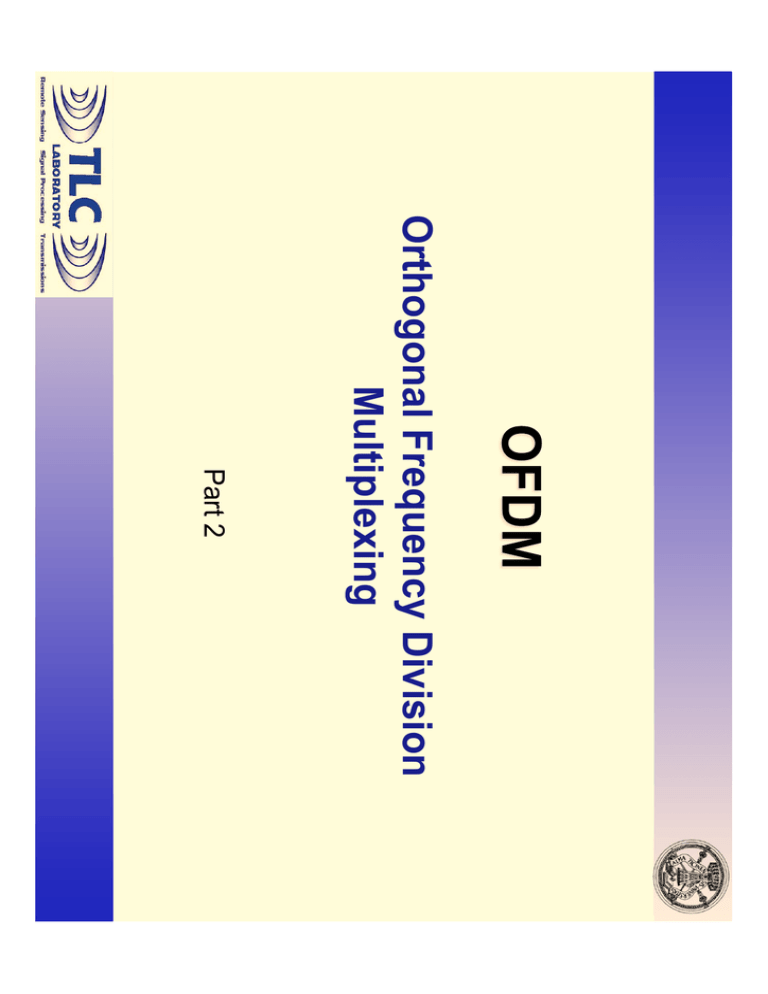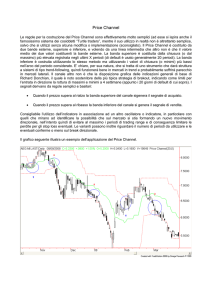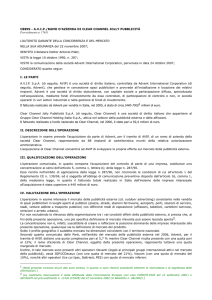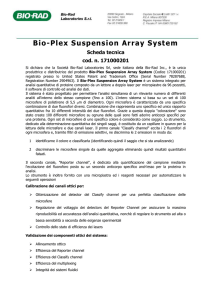
Orthogonal Frequency Division
Multiplexing
Part 2
• Multipath channel
• Multipath time variant channel
• Multipath channel with frequency offset
Algoritmo
per la stima di canale
in multipath channel
S. Jain, P. Gupta and D. K. Mehra, “EM-MMSE based Channel Estimation for OFDM Systems,” in Proc. IEEE,
I.C.I.T., 2006, Mumbai, pp.2598-2602
• Modello di riferimento
• Uso dei toni pilota
• Algoritmo EM-MMSE:
– The (Expectation Maximization) EM è una forma di maximum
likelihood (ML) detection con parametri non noti.
– E-STEP: Calcola il valore atteso dei dati inviati usando le stime
correnti dei parametri e dei dati osservati.
– M-STEP: usa le stime dei dati inviati per determinare il
parametro che massimizza la probabilità di aver osservato quei
dati inviati
• E step: dati trasmessi con MMSE usando
– simboli ricevuti
– stima del canale alla p-th iterazione
• M step: canale
• 4-tap multipath channel, QPSK, N=128
Algoritmi
per la stima di canale
in multipath time variant channel
Y. Mostofi and D. C. Cox, “ICI Mitigation for Pilot-Aided OFDM Mobile Systems,” IEEE Transaction on Wireless
Comminication, vol.4, no. 2, March 2005
• Modello di riferimento
• Uso dei toni pilota
ICI
• Approssimazione lineare a tratti
• Estrazione toni pilota valori medi
• Metodo iterativo
No
– Stima di X
– Calcolo pendenze con prefisso ciclico
Inizializzazione
Estrazione
toni pilota
Calcolo X
Calcolo
pendenze
Converge?
Sì
• Approssimazione lineare a tratti (2 pendenze)
• Equazione risolutiva
• Estrazione toni pilota valori medi
• Calcolo pendenze con simboli precedente e
successivo
• Canale
– Profilo di canale (dB): [-3.01 -8.24 -13.01 -5.23]
– Velocità utente: 100 Km/h
• Sistema WiMax
Metodo I
Metodo II
Algoritmi
per la stima di canale
in multipath channel
with frequency offset
L. Favalli, P. Savazzi, A. Vizziello, “Frequency Domain estimation and Compensation of Intercarrier Interference
in OFDM Systems,” proc. Of the 10th International Symposium on Spread Spectrum Techniques and
Application, Bologna, August 2008.
L. Favalli, P. Savazzi, A. Vizziello, “Estimation and Mitigation of Intercarrier Interference for OFDM Systems in
Multipath Fading Channels,” proc. Of the 4th IEEE International Conference on Wireless and Mobile Computing,
Networking and Communications, Avignon, October 2008.
• Proposed methods:
–Pilot tones
–Algorithm I: AWGN channel with frequency offset
• Estimate ICI coefficients: CORRELATION
• Recover data: MMSE
–Algorithm II: extension to multipath channel
Radio access architecture
– Modulation/demoduation: IFFT/FFT
– Time variant multipath propagation: channel h(t)
– AWGN noise
– Frequency offset at local oscillator
• Relationship in the frequency domain
• Channel matrix includes ICI effects
l,m accounts for the interference of the m-th subcarrier onto the l-th one
• Several factors simultaneosly
• Large size of matrix some simplifications:
– Frequency offset or one time variant path
is circular
– Mutipath and frequency offset
is split in two parts: one circular and another diagonal
– AWGN channel and frequency offset:
• can be represented as follows:
the first row
the other rows (circular shift)
• Compute only the coefficients of the first row
• Further simplification:
The loss of orthogonality interests a limited number of adiacent subcarriers
Consider only the first I coefficients of each row, with I<<N
– Multipath channel and frequency offset:
• can be represented as follows:
• C takes into account frequency offset effect: circular
• H is the channel frequency response: diagonal
• AWGN channel and frequency offset
• Iterative Method
• Equations in the frequency domain to
– Channel Estimation
– Symbol Estimation
R. R. Lopes and J. R. Barry, “Blind Iterative Channel Identification and Equalization,” IEEE International Conference on Comminication, vol.7, pp. 2256-2260, June 2001
• First row
• d is the position of interfering subcarrier with respect to the considered k
• I is the maximum number of interfering subcarriers
– Equation:
• Frequency domain
• Multicarrier system
• Recover ICI channel matrix
– Proposed Method:
• Time domain
• Single carrier system
• Recover channel impulse response to reduce ISI
– Derived from Lopes and Barry1:
Channel Estimation through CORRELATION
1
Symbol Estimation via MMSE
– Complex coefficients obtained by MMSE equalization
•
is supposed known at the receiver
is the transpost conjugate
– Coefficients multiply received vector
•
Proposed Scheme
• After FFT
• Channel Estimation: Received Data and Estimated Transmitted Data are used
• Symbol Estimation: Received Data and Estimated Channel are used
• Multipath channel and frequency offset
• Matrix Approximation:
• Compute matrix H
• Iterative Method
– Calculate matrix C: CORRELATION
– Symbol Estimation: MMSE
Pilot tones
equally spaced on subcarrier2
Compute matrix H:
•
through an IFFT of length
• Diagonal elements of H on these positions
• Taps coefficients
Y. Mostofi and D. C. Cox, “ICI Mitigation for Pilot-Aided OFDM Mobile Systems,” IEEE Transaction on Wireless Comminication, vol.4, no. 2, March 2005
• H in frequency domain
2
• Compute matrix C by CORRELATION
• Calculate matrix • Data Recovery by MMSE
The algorithm is summarized in the following table:
5
4
3
2
1
Estimate Data by MMSE
Calculate Estimate C by CORRELATION
Estimate H
Extact pilot tones
Initialization: set to 0 estimate of Operation
6
If Method does not converge go to step 4
Step
7
Expectation Maximization framework:
– E step
– M step
General EM Scheme
Application to the Proposed Algorithm
– Compute matrix H
– E step:
Recover Data by MMSE
– M step:
Calculate ICI matrix
Re-compute MMSE equalizer coefficients
Two sets of simulation for Method I:
– AWGN channel with carrier frequency offset
• Normalized frequency offset
– One tap time-variant channel
• Channel condition of the compared method
• Time varying channel with Jakes model
• Speed = 80 km/h fD = 371 Hz fD Norm = 3.8%
•
Increasing the number of pilot tones
the performance improve
BER varing pilot tones
AWGN channel with offset 0.2
•
Pilot tones to initialize the algorithm and
improve convergence speed
ICI coefficients convergence
•
After a dozen iterations there is a
perfect match with the target value
BER for different offset values
•
•
2 or 3 estimated ICI coefficients
Larger coefficients are better
recovered
BER in one-tap time variant channel
•
•
2 estimated ICI coefficients
Compared with pre-DFT algorithm to
recover ICI
Set of simulation for Method II:
– Multipath channel: two taps with power -0.4576 dB, -5.2288 dB
– Normalized frequency offset: 0.1 and 0.2
Constant multipath
Slow time variant multipath











